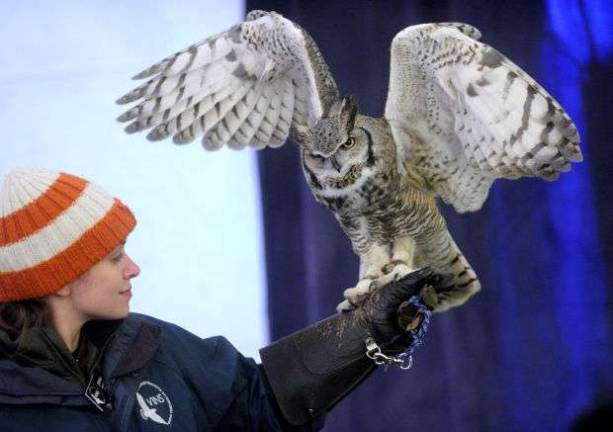Strange bedfellows


“Whooo’s awake? Mee toooo. Hoo-h’Hoo, hooo, hooo.” I rolled over. “Whooo’s awake? Mee toooo.” Well, now I was awake. There are many things I’ve done over the past few years that I never guessed I would do. Sharing a hotel room with a talkative Great Horned Owl for two nights is one of them. Yet there I was, waking up repeatedly throughout the night to the sound of our beloved owl, hooting incessantly. Next to him, the Harris’s Hawk grumbled his annoyance and the Rough-legged Hawk shifted in her crate, while the one-winged Barred Owl thrashed around in hers. The young American Kestrel, usually so quick to make noisy begging calls, was thankfully silent, and the mature 18-year-old Red-tailed Hawk was stoic.
I traveled to Fort Edward, New York, with my feathered companions and Hannah Putnam, a colleague at the Vermont Institute of Natural Science, for the third annual Winter Raptor Fest at Gallup Ridge Farm. Wildlife rehabbers, falconers, nature center representatives, photographers, and bird enthusiasts flock here to get an up-close look at some of the most fierce and impressive creatures of the avian world. After being deemed non-releasable from a variety of injuries—most often the result of car collisions—these raptors were trained on the glove for the purpose of educating people about the role they play within the natural world.
The Winter Raptor Fest, sponsored by the non-profit group Friends of the Washington County Important Bird Area (IBA), is a fundraiser to protect the state-endangered Short-eared Owl and other at-risk birds, such as the state-threatened Northern Harrier, which depend on grassland habitat because of their low, aerial hunting style. Washington County’s 13,000 acre grassland area, designated an IBA in 1997, is one of few large continuous grasslands that remain in Eastern New York.
The Short-eared Owl spends its winters in New York’s grasslands, where it can feast on small rodents such as shrews and meadow voles. But reforestation, development, habitat fragmentation, and changes in agricultural practices have threatened the habitat it relies on.
With fewer than 100 Short-eared Owls breeding in New York State, Friends of the IBA is working to protect their habitat by conserving and acquiring critical lands within the IBA from willing landowners. As a result of the previous two years’ Winter Raptor Fests, four landowners have signed 390 acres into protection under conservation easements.
During the first evening of the festival, Hannah and I traveled down the road with other birders to a prime grassland area, where tufts of meadow grasses poked above the thin covering of snow. We stood in the cold dusk air, scanning the fields with binoculars. There, perched on top of a bare tree, a Short-eared Owl swayed in the wind, and beyond it, another fluttered over the field like a butterfly. Seeing these birds utilizing these protected grasslands to look for their evening meal only reinforced how critical the habitat is for their livelihood.
After a full weekend of performances, I’m sure our birds were eager to get back home to Vermont to their spacious enclosures. Our Great Horned Owl, normally so talkative, was oddly silent that afternoon and during the drive home. He only hooted once to assure us that he was okay. But as soon as I put him back on the perch in his enclosure, he started hooting again. This owl talks so much that for the past several years, he has attracted a female Great Horned Owl to roost outside his enclosure. I didn’t believe the stories until I saw her myself. Within minutes of putting him back in his enclosure, I saw his lady flying above, and the two started hooting at each other. I listened to their conversation for a few minutes before continuing to clean up after all our birds. I’m sure he had lots to tell her about his weekend in New York.